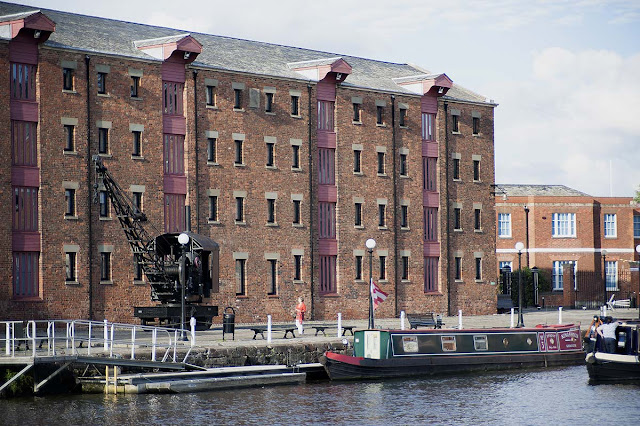TAOP Part 1 - Exercise 4 Focal Lengths
This exercise is about the angle of view which changes subject to the focal length of the lens.
For this exercise I've used a 28-105mm zoom lens. All images are taken from the same spot with the camera on a tripod. A set of images have been taken with the camera zoom used at its widest and then through to its longest focal length to demonstrate how the image in the frame can change. All images have been taken with the the black crane as the point of focus
Image 1 - 28mm
This image is at the widest setting of the lens, 28mm. Unfortunately I've not captured much in the foreground but what I have done using this lens is to capture the expanse of the water and the perspective f nearby buildings and the blue but semi cloudy sky. A sense of scale is given to the viewer at this focal length. At this wide angle the black crane is hard to make out. The left hand side of the image shows the Docks walkway. Can you notice the big fluffy cloud just above and between the 2 large sets of buildings.
Image 2 - 46mm
The lens has been zoomed in at 46mm and the walkway is not out of the picture and without this the viewer could be mistakenly led to think the image was taken on the water, perhaps from a boat. Immediately without this dark walkway (it was in shadow) the overall image appears lightened. The closer zoom shows a bit more detail of the crane and the mid ground boats are more easily identifiable
Image 3 - 60mm
At 60mm the focal length is increased and the angle view is become decreased so that the blue sky is now hardly visible and the quirkiness of the fluffy cloud hard to identify as it was in Image 1. Figures are not more visible but noticeably the expanse of water now takes up less of the image and becomes less dominant than in the other images. Shadow on the building from the sun's position on the left of the frame is now more visible.
Image 4 - 80mm
The lens now has a focal length of 80mm and any element of blue ion the sky is now no longer visible. Figures are now more visible, person in white sitting down bottom left, person in orange walking bottom right and person in white on boat bottom far right. Looking at these images now I realise I've made a careless mistake in that my camera position has result in the white dome of the lamppost in every image covering the crane, the focus subject of this set of images. Ordinarily I would re-shoot having identified this mistake but I think I will leave this as reminder that obvious and careless mistakes can happen quite easily.
Image 5 - 105mm
At 105mm, the longest focal length my lens has I'm unable to really show the crane as the dominant element in this image. The woman in orange on the right of the crane walking towards it is seen looking at the crane and this would help the viewer focus in on the crane. If had wanted to make the crane more dominant in the image I could do this a number of ways:
a) use a lens with a bigger focal length to zoom in closer on the subject
b) move the camera nearer the subject though this does change some elements of the image as a result of the camera to subject distance being shortened
c) In post processing use zoom crop. The level of accurate focusing will be identified when this is done. The next image demonstrates a zoom crop.
Image 6 - Zoom Crop
A zoom crop as part of post processing has enabled me to zoom in closer on the image having already reached the zoom limit of my lens at 105mm. In this image the crane can be seen as more dominant and the lady in orange to right can be seen focusing her attention on the crane, helping the viewer do the same. In addition to my mistake of taking this image with the white light dome in front of the crane, a perhaps undesirable litter bin can also be seen.
Exercise Learning's
a) The focal length of a lens, and/or the focal range of a zoom lens will change the angle of view that can be captured within the frame.
b) Elements of an image can be isolated by changing the focal length of a lens, this can have both positive and negative effects depending on the photographer's image design and visualisation.
c) The subject within an image can be made stronger not only by it becoming a more dominant element of the image if zoomed in upon, but in the case of image 6 by being the subject of attention of a passer-by also captured in the image.
d) The focal length selected with the lens is not just the only way of making a subject being in the frame, moving the camera nearer or performing a zoom crop as part of post processing can also achieve this
e) Concentration must be maintained in photography composition basics, in performing this exercise the inclusion of a lamppost over the subject was a big mistake. How did I do this - It was not immediately visible from my eye or when composing the frame at its widest :)






No comments:
Post a Comment